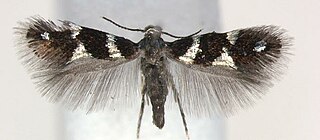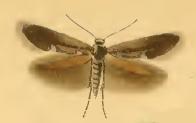
Urodidae, whose species are commonly known as false burnet moths, is a family of moths in the lepidopteran order. It is the type genus in the superfamily, Urodoidea, with three genera, one of which, Wockia, occurs in Europe.

The Heliozelidae, commonly known as shield-bearer moths, are a family of small, day flying monotrysian moths distributed worldwide. The larvae of most heliozelid species are leaf miners who cut distinctive shield-shaped cases from the surface of the host leaf, hence the common name. Some species are considered pests of commercial crops such as grapevines, cranberries, and walnuts. The taxonomy of this family is poorly understood.

Heliozela hammoniella is a moth of the Heliozelidae family. It is found in Ireland, Great Britain, the Netherlands, France, Germany, Austria, the Czech Republic, Poland, Romania, Lithuania, Latvia, Fennoscandia, and Russia.

Heliozela sericiella is a moth of the Heliozelidae family found in Europe. The larvae mine the twigs of oaks, causing a gall.
Heliozela argyrozona is a moth of the family Heliozelidae. It was described in the genus Antispila by Edward Meyrick in 1918 and moved to the genus Heliozela by Erik J. van Nieukerken and Henk Geertsema in 2015. It is found in South Africa.

Heliozela is genus of moths of the family Heliozelidae, described by Gottlieb August Wilhelm Herrich-Schäffer in 1853.
Heliozela ahenea is a moth of the Heliozelidae family. It was described by Walsingham in 1897, and is found in the West Indies.
Heliozela anantia is a moth of the Heliozelidae family. It was described by Edward Meyrick in 1897. It is found in Tasmania.
Heliozela autogenes is a moth of the Heliozelidae family. It was described by Edward Meyrick in 1897. It is found in Queensland.
Heliozela catoptrias is a moth of the Heliozelidae family. It was described by Edward Meyrick in 1897. It is found in New South Wales.
Heliozela crypsimetalla is a moth of the Heliozelidae family. It was described by Edward Meyrick in 1897. It is found in South Australia.
Heliozela cuprea is a moth of the Heliozelidae family. It was described by Walsingham in 1897. It is found in the West Indies.
Heliozela eucarpa is a moth of the Heliozelidae family. It was described by Edward Meyrick in 1897. It is found in New South Wales.
Heliozela isochroa is a moth of the Heliozelidae family. It was described by Edward Meyrick in 1897. It is found in New South Wales.
Heliozela microphylla is a moth of the Heliozelidae family. It was described by Edward Meyrick in 1897. It is found in Western Australia.
Heliozela nephelitis is a moth of the Heliozelidae family. It was described by Edward Meyrick in 1897. It is found in New South Wales.
Heliozela prodela is a moth of the Heliozelidae family. It was described by Edward Meyrick in 1897. It is found in New South Wales, Queensland and Tasmania.
Heliozela subpurpurea is a moth of the Heliozelidae family. It was described by Edward Meyrick in 1934. It is found in Japan.
Heliozela trisphaera is a moth of the Heliozelidae family. It was described by Edward Meyrick in 1897. It is found in New South Wales and South Australia.



